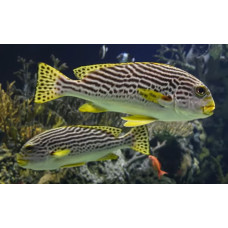Latin name
Plectorhinchus lineatus
Other names
Oblique-banded sweetlips, diagonal-banded sweetlips, Goldman's sweetlips, lined blubber-lips, lined sweetlips, many-lined sweetlips, striped sweetlips, yellowband sweetlips.
Identification
This species is characterised by the following features: chin with 6 pores, no median fossa; gill stamens on first gill arch 7-11 + 1 + 17-19 = 26-30; D XIII, 18-20, length from 3rd to 5th spine; lips fleshy, moderately swollen with age; scales ridged (rough to the touch); lateral scales about 54-58 cm long; body depth 2.6-2.9 inches across; caudal fin slightly rounded in juveniles, truncated in adults.
Features of fish fins
Dorsal spines (total): 12-13; Dorsal soft rays (total): 18-20; Anal spines: 3; anal soft rays: 7-8.
Fish colouring
General colour light grey, white on belly. Protruding yellow lips. The upper part of the body is marked with a large number of broken diagonal black stripes. The fins are yellow, with black spots on the caudal, anal and dorsal fins, and red spots at the base of the pelvic fins. Juveniles have several horizontal or slightly oblique dark brown stripes which break up as the fish grows until the body colour is dark chocolate brown on top and a web of thin white lines runs down the back. As the fish grows, the broad brown stripes on the flanks break up into spots, which also become smaller as the fish grows.
Distribution
They live in the eastern Indian Ocean and the western Pacific Ocean. Their range extends from Indonesia east to the Philippines and New Ireland, north to the Ryukyu and Ogasawara Islands, and south to New Caledonia and Australia. In Australia, they are found on Scott Reef in Western Australia, Ashmore Reef in the Timor Sea and along the Great Barrier Reef to the Capricorn Islands and the Gold Coast Seaway in Queensland.
Habitat
Tropical marine species. Prefer deep waters from 1 to 35 m (3 feet 3 inches and 114 feet 10 inches), on both inner and outer reefs.
Size
This species reaches a maximum total length of 72 centimetres.
Behavior
These fish can be found both singly and in groups along coral slopes in clear water. Juveniles are solitary and inhabit shallow, sheltered reefs. They are usually nocturnal, feeding on benthic invertebrates in open areas of sand and seagrass beds at night and resting during the day. During the day they can often be found resting near coral thickets, columnar coral projections that are often exposed at low tide.
Food and feeding habits
Feeds on benthic invertebrates.
Reproduction
Clusters of spawning individuals have been observed off the coast of Palau during the new moon; this oviparous species forms pairs to spawn.
Fishing
Small commercial fishery. Fished by line and spear, the catch is sold fresh, although a small amount is preserved by salting.
Relationship with a person
Used in aquariums.
| Classification | |
| Phylum | Chordata |
| Class | Actinopterygii |
| Squad | Perciformes |
| Family | Haemulidae |
| Genus | Plectorhinchus |
| Species | P. lineatus |
| Features | |
| Conservation status | No information |
| Habitat | Pelagic |
| Life span, years | No information |
| Maximum body weight, kg | No information |
| Maximum length, cm | 72 |
| Sailing speed, m/s | No information |
| Threat to people | Edible |
| Way of eating | Bentophage |
Yellowbanded sweetlips
Tags: yellowbanded sweetlips



